Visitor Behavior Analysis
What is visitor behavior analysis?
Visitor behavior analysis is a method of conducting qualitative research on visitors’ website behavior. Visitor behavior analysis involves employing multiple qualitative tools that help you track your website’s performance, understand website visitors’ on-site behavior, identify experience breakages, connect with individual visitors for feedback and suggestions, and then utilize all the insights to optimize the site-wide experience.
It also gives you a clear picture of how critical pages like the homepage, product pages, landing pages, and so on are performing in terms of keeping visitors engaged and solving their pain points.
Before getting into further details about website visitor behavior analysis, let us first understand the difference between quantitative and qualitative research methods and the kind of pain point each one helps you solve. In the optimization arena, there are two approaches to research – quantitative and qualitative.
Quantitative research involves using tools like Google Analytics, some types of website surveys like NPS surveys, rating scale surveys, and other tools that give you numerical data on how your website is performing.
Data gathered through quantitative gives you an indication of how your website and the different pages of it are performing by giving you hard numbers like bounce rate, conversion rate, cart abandonment rate, form abandonment rate, page views, subscription rate, and so on. These numbers however only give you a picture of how things are on your website and not why they are so. This is where qualitative research comes in.
Qualitative research involves employing research methods that track user behavior through their entire journey on your website to discover experience breakages. It empowers you to step into your visitors’ shoes, see what they saw, experience what they experienced, and draw actionable insights from them which can be tested and deployed in the optimization stage. Whenever a visitor visits your website, visitor behavior analysis assumes the role of website visitor tracking software and maps their entire journey online.
Qualitative research enables you to learn directly from known as well as anonymous visitors what they liked, what they disliked, what does not belong on the website, what should be tested for optimization, and more. It provides direct causal explanations for the numerical data that quantitative research equips you with. Plus, you can make the most out of your existing website traffic without having to invest in new traffic.
And visitor behavior analysis, which is in essence qualitative in nature, helps you do all that. In fact, visitor behavior analysis sits at a very pivotal platform in the world of Experience Optimization (ExO). This will become clearer as we dive deeper into how visitor behavior analysis helps you understand your audience better, benefits your business, and how it is being used across industries to carry out Experience Optimization programs with the aim of optimizing conversion rates.

What is visitor tracking?
Visitor tracking refers to the process of tracking the activities and characteristics of a website visitor. This gives site owners in-depth insights into the needs and requirements of the visitors by analyzing their on-site activities and behavior. Visitor tracking also provides information around how a visitor landed on your website, what’s their geographic and demographic profile, their age, the device they’re using, and so on.
Such visitor behavior analysis enables site owners to identify how visitors interpret and interact with their site and take necessary measures such as optimize their site to provide the best possible user experience.
Listed below are 3 advantages of tracking website visitor activities.
Website Performance
Visitor tracking is one of the best ways to gauge the performance of your website. It gives you a view into whether or not people like your site, offerings, and whether or not they’re able to find what they came looking for. You can use this information to revamp your site pages, remove frictions, improve sales funnels, and get more conversions.
Website Analytics
Tracking visitor behavior and demographic data can help you make better business decisions. For example, a content specialist may want to monitor what content pieces are driving organic traffic, generating MQLs, and identify areas of improvement.
Advertising
Visitor data tracking also proves beneficial when you’re planning to run paid ads across various platforms. You’ll not only target the right set of audiences across different platforms but also increase the chances of engagement and conversions. Some basic visitor information that a website tracks include search history, location, user interest, and time.
4 best analytical tools to evaluate visitor behavior
Visitor behavior analysis sits at the center of any Experience Optimization program because it helps uncover certain actionable insights that quantitative analysis methods fail to equip you with. Hence, the tools used to conduct visitor behavior analysis also work to achieve the same goal: identifying areas that need improvement for your website to be optimized through testing, by gathering actionable insights from the visitors directly.
There are 4 tools through which you can conduct visitor behavior analysis namely, website heatmap, session recording, website surveys, and form analytics. Let’s look at each tool in a little more detail:
1. Website heatmaps
The first tool that is widely used by marketers for conducting visitor behavior analysis is Website Heatmap. Website heatmap tracks visitors’ on-site behavior like scrolls, clicks, mouse movement, and so on, and visually represents that data in using different colors and forms that represent visitors’ exact activity on your website. There are 5 different types of website heatmap that marketers employ to understand their visitors better and find explanations for the performance of various metrics :
A. Heatmaps
Heatmaps visually represent the data collected on visitor behavior on different web pages using a color scale of warm to cold colors. Here, the warmest color depicts the areas of maximum engagement and interaction, with the coldest color depicting areas of least interaction – everything else falls in between. Heatmaps help you identify areas on your web pages that receive the most attention, where visitors click most, where visitors click least, and so on.
Such insights can then be used to make data-backed optimization decisions like CTA placement, link placement, image placement, removing redundant information, and more.
B. Scrollmaps
Scrollmaps visually represents the scrolling behavior of your visitors with the help of colors, and also reflect the percentage distribution of visitors across the page based on how much they scroll. It helps you figure out how far visitors scroll down on your page, sections in which they spend the most time, sections of a page beyond which visitors do not scroll, and more.
Such insights help you identify the best CTA placement options, the optimum length your pages should be, the best length for your blog posts, and more which, you can then utilize to build hypotheses to be tested for experience optimization.
C. Clickmaps
Like heatmaps, clickmaps also give you real-time data on how visitors interact with your web pages. They track the visitors’ clicks and help you identify which section of a page visitors click most and least on, which images they click on, links that are clicked often and those that aren’t navigational gaps, and so on.
Such insights can help you optimize your web pages and overall website experience by helping you identify if the CTAs are placed in the most clicked sections if there are images that visitors are clicking on expecting it to be hyperlinked if links are placed where visitors expect them to be, if your website’s navigation matches visitor expectations, and so on. Such actionable data then helps you formulate data-backed hypotheses to be tested for optimization.
D. Mouse tracking heatmap
Mouse tracking heatmaps track how visitors’ cursors hover on a page. Based on their cursor’s movement, mouse tracking heatmaps help you discover where visitors spend the most and least time in, sections through which they just scroll over without paying much attention, and so on.
Such insights can help you identify popular sections of web pages where you can place important content, primary CTAs, and so on. It also helps you identify elements that are confusing, redundant or creating friction in users’ experience.
E. Eye-tracking heatmap
Eye-tracking heatmaps give you data on your visitors’ gaze behavior. They help you identify images on which visitors’ gaze is fixed for a substantial amount of time, elements that divert their attention from important content, and so on. All this is tracked based on 2 parameters namely fixation length and frequency, and then graphically presented in the form of hot and cold spots based on your visitors’ eyeball movement.
Such insights can help you identify where visitors’ eyes are fixed on most if they are being distracted by any element (visual or textual) on the web pages, and help you place the most important elements in the most popular section by tracking visitors’ gaze pattern.

2. Session recording
Session recording enables you to record user and visitor sessions on your website which is later analyzed to dig insights into how visitors interact with your website. It enables marketers to step into their audiences’ shoes and experience first-hand what they experienced on your website. Session recording not only enables you to understand visitor behavior but also identifies leakages in the funnel and friction areas on your website.
Such insights enable you to make data-backed optimization decisions, cater personalized fixes to pain points of different visitor segments, derive explanations for various metrics of various web pages and the website overall, apply insights to other marketing activities, increase conversions, and so on.
3. Website surveys
Website (intercept) surveys are the most direct way to get the feedback of site visitors and gauge the kind of experience they had on your website. Broadly, there are 3 types of website surveys, namely, pop-up surveys, widget surveys, and collapsible pop-up surveys:
- Pop-up website surveys: These surveys pop-up on your visitors’ screen when they are active on a browser. They pop up when an event is triggered. Based on the way they are configured, pup-up surveys can appear anywhere across the visitors’ website journey.
- Widget surveys: These surveys take the form of a small widget in a corner of the web page that pops-up on the screen only when clicked on by the visitor. Widget surveys give visitors the space to decide if and when they want to submit feedback on their experiences.
- Collapsible pop-up surveys: These surveys are a mix of the first two in that they pop-up on the visitors’ screen when an event is triggered but, unlike pop-up surveys, when visitors close the pop-up, they do not disappear from the screen. Like widget surveys, on being closed by the visitors, collapsible pop-up surveys collapse and take the form of a widget. With this type of survey, you can reap the benefit of two means in one exercise.
Using the insights and feedback gathered using website feedbacks, you can get real-time feedback, reach a wider and more relevant demographic, get feedback at different touchpoints of the funnel, and all this while enjoying a high response rate. All this facilitates the creation of an idea factory whose constituents can then be tested for optimization.
4. Website form analytics
Besides the above-mentioned qualitative tools, website form analytics provides conversion-centric information regarding the performance of your website’s forms by track metrics like interaction time, hesitation time, abandonment rate, total time spent, and so on for each field of the forms.
Such metrics, when combined with the insights generated using other visitor behavior analysis tools, can help you make data-backed decisions to improve the overall form filling journey and increase the chances of conversions. Using form analytics, you can identify redundant fields, fields, where visitors spend the most time, and more which when optimized, can increase form submissions on your website substantially

6 reasons why you should conduct visitor behavior analysis
With website heatmaps, you can track and analyze visitors’ mouse movement, scrolling behavior, click patterns, and more, and then discover patterns in the behavior of different segments.
With session recording, you can see what visitors saw, where they scrolled, where they showed signs of struggle in understanding any content or element, where they struggled to find any information, which stage and page they dropped off on, and much more.
With website surveys, you can get direct feedback on your website and products and act on them promptly.
And with form analytics, you can optimize every form on your website and every field on each form to increase submissions.
Listed below are some of the most important benefits that businesses can reap out of using visitor behavior analysis:
1. Segment audience based on common traits
With Pandora’s Box equivalent of insights generated by conducting visitor behavior analysis, you can identify all the various segments that form your audience base. Once you have your segments ready, you can start creating audience segments for either one segment or a combination of two or more segments.
For instance, an e-commerce store selling clothes may identify the following visitor segments constituting its audience base: Europe and US visitors (geography), Android and IOS users (the operating system for mobile), Between the ages of 16-35 years (age group), using Chrome, Firefox, or Safari (browsers), and so on. Now, when planning a campaign, you can either personalize it for one of these segments or for a combination of two or more segments like US visitors, between the age of 25-35 years, using Chrome on MacBooks can be the target segment from a campaign you plan for these specific segments.
Empowering you to segment visitors based on data, visitor behavior analysis enables you to send personalized campaigns and design personalized website experiences. This results in the website’s conversion rate moving upwards north.

2. Get in your visitor’s shoes
Whether you use website heatmaps, session recording, web form analytics, or website surveys, the insights and feedback that these tools record are an extension of what the visitors experience on your website. This is one of the most important benefits that marketers can leverage to up their optimization game. If you understand your visitors well and know exactly what they want from your website, you will be able to make data-backed changes by testing as many hypotheses as you formulate using the insights generated.
3. Build a stellar website experience
The key to creating a website that converts is making sure it solves the pain point of every visitor segment and allows them to easily access the information they are looking for. But in the online world, multitudes of things and co wrong unnoticed: there might be a tiny element that puts visitors off, your checkout process may be too long, your website’s navigation may be creating friction, and so on.
Visitor behavior analysis helps you discover such leaks in your website’s purchase funnel and enable you to unearth insights by studying your visitor’s own experiences. These insights equip you with data that enable you to build a website that takes visitors from one stage of the funnel to the other with minimum effort on their part, thereby delivering a stellar website experience.
4. Identify popular sections across the website
You may have the world’s best products and services at the most justifiable rates. You may also have the best-written content up on your website. But, you may still be struggling with low conversions. The reason may be many, but the most likely cause for it can be that while you do have the best-written content about the products and services, they are placed in sections where visitor attention is rarely directed.
Visitor behavior analysis conducted using website heatmaps and session recording provides you with insights on which sections visitors spend the most and least time, which images retain visitors’ gaze for the longest period, which sections, images or links visitors click on the most and least, how much visitors scroll through a page on your website, and more.
Being equipped with such insights enable you to place the most important content and elements on the most popular and attention-grabbing sections of the web pages, discover missing links and images, and eliminate redundant ones, identify the optimal length your web pages should be of, and more.
5. Identify friction across the funnel
When you conduct visitor behavior analysis using tools like session recording and website surveys, in addition to getting page-wise insights, you also get insights into the visitors’ journey across the funnel. You can watch recorded user sessions of different segments based on your goal and gather insights on visitor behavior throughout their journeys. You can see first-hand what your visitors saw, what they were looking for, how easy was it for them to navigate through different funnel stages if visitors bounced, what caused the friction that nudged them to bounce, identify browsing patterns and find solutions to the problem causing elements that adversely affects your website’s conversion rate.
With tools like website surveys, you can ask for feedback from your visitors anytime and anywhere in the funnel. If visitors show exit intent, ask them why they are leaving and incentivize their stay; if visitors show exit intent after adding product/s to their carts, ask them the reason for it and if there was anything you could do to change that; ask repeat visitors the reason they came back to your website; after a transaction is complete, ask buyers if they would come back to your website, and why; run NPS survey to judge brand loyalty, and more. You can use all the insights generated to make data-backed changes to your website, products, and services that match visitor expectations.
Visitor behavior analysis enables you to discover the biggest as well as the smallest leakages in your sales funnel, identify the root cause of the leakage, seek solutions in visitor behavior and feedback, and build a website with a smooth and superior experience across the funnel.

6. Increase website conversions
All the benefits that businesses draw by conducting visitor behavior analysis are all directed to one goal – increasing conversions. For a B2B SaaS company, it may be increasing the number of quality leads, for an eCommerce store, it may be hitting the highest profit mark ever, or for a media and entertainment company, it may be increasing the average screen time of their audience.
Every insight unearthed means another idea to be tested for website optimization. You can run A/B tests, Split URL tests, Multivariate tests, or Multipage tests based on the goal you are trying to achieve.
Hence, it is important that you reach out to each relevant visitor – each visitor your data suggests can give you insights on how to improve your website’s experience – should be reached out to; directly or indirectly. And visitor behavior analysis gives you the option to choose which route to take but, in the end, the target that it helps you reach is increasing your website’s conversion rate – be it increased, good quality lead count, increase in the number of purchases, or increasing subscriptions.
Top 5 website visitor tracking tools
Listed below are the top 5 visitor tracking tools you can use to know your site visitor’s behavior from different angles and use the information to craft better site experiences.
1. VWO
VWO is an excellent experience optimization solution that enables you to track visitor behavior and use the data to improve site performance. You can use VWO Insights to:
- Get an overview of visitor clicks on key pages elements
- Understand the numeric values of page clicks through a visual approach
- Identify frictions and bottlenecks based on user experience
- Get first-hand inputs to design a more optimized website
Besides these, VWO also gives you the leverage to run multiple A/B tests in order to understand user psychology and use the data to improve experiences.
2. Mixpanel
Mixpanel is a full-featured visitor behavior tracking tool that enables experience optimizers to understand their target audience in a better manner. It offers features that help you map the success of new feature rollouts, quickly analyze and visualize critical data, and conduct in-depth optimization plans to improve user experience.
With its User Profile feature, you can also get key information about users such as who they are, why and where they’re facing issues while navigating your site, their take on your product, and so on.
3. Google Analytics
Google Analytics is one of the best quantitative tools to track visitor behavior. The application offers an array of features that helps experience optimizers to craft effective optimization strategies. One such feature is real-time user tracking.
When using GA’s real-time tracking feature, you can monitor the usage of your site’s mobile application, map the performance of on-going promotions, monitor goals set in line with site changes, and so on.
4. Hotjar
Hotjar is a visitor behavior analytics, and feedback software that helps you understand why visitors do what they do on your website, do they (or not) take specific actions on your site and get the voice of the customer (VoC) feedback from them.
Using Hotjar, you can track product experience insights including:
- aggregated visitor clicks, scrolls, and mouse movement with heatmaps;
- individual visitor’s browsing behavior using session recordings
- user feedback using on-site surveys and feedback widgets.
5. Crazy Egg
Crazy Egg is another website optimization, heatmap, and A/B testing tool that helps you track user experience and use the data to improve your site’s performance and overall visitor experience.
Using Crazyegg, you can:
- Run A/B test on different web pages
- measure the psychology of users when on your platform using heatmaps and website recordings
- Identify friction areas and find solutions to fix the problem
6 common mistakes to avoid while conducting visitor behavior analysis
For any business, two pieces of information are most important to its survival. One, in order to make decisions, a business needs to know the ground reality of where it stands in the market now. Second, in order to plan forward and determine progress, it needs to know where it stood in the market in the past.
These two sources of information individually don’t convey much information. But combined together, they provide actionable insights. ‘Where am I now’ and ‘where was I’ is what you need to know if you need to plan for ‘where I want to go’. And visitor behavior analysis can help you find data-backed answers to all these unless you make any of the following common mistakes that marketers stand at the risk of making:
1. Behavior analysis without goals
Essentially, your exercise to understand visitor behavior using various tools like website heatmaps, form analytics, session recording, and so on is shaped by the goal/s you set. And, this is why conducting visitor behavior analysis without setting up any specific goal/s is the first mistake that marketers are susceptible to making.
Conducting visitor behavior analysis without any specific goal/s being set increases the chance of you not knowing what to look for while looking at a resultant heatmap, and you may also get overwhelmed with all the colors it uses; or, you might end up with a heap of user session recording, and might end up revisiting those recordings again and again without unearthing any actionable insights thereby wasting a lot of time and resources; and so on.
2. Incorrect sample size
Another mistake marketers often become prey for is setting the incorrect sample size for data collection. For the end result of your visitor behavior analysis exercise to be statistically significant, you need to have enough responses to your website surveys, enough heatmaps captured, enough user sessions recorded, and so on. Without having enough collected data on the right number of visitors, your analysis will be flawed and the resulting product of the exercise will not be representative of your entire visitor base.
3. Incorrect sample period
While setting up the sample period, marketers can make 3 mistakes:
- Choosing too long a sample period: You will be swamped with collected data and stand the risk of spending too much time analyzing it for insignificant insights.
- Choosing too short a sample period: You will end up with too little data for analysis and get statistically insignificant results which will end up not being representative of your entire audience base.
- Not considering external factors: At the cost of ignoring external factors like days of the week, offers, holidays, festive sales, etc. Buyer behavior during such periods is starkly different from when these factors don’t influence their decision to purchase. If data is collected during these periods, the resulting picture will not be true for year-round purchase behavior.
4. Lack of sophisticated tools
In the last decade or so, the popularity of visitor behavior analysis among marketers as a means of unearthing actionable visitor behavior insights has been growing exponentially. Naturally, as the demand for it increased, the number of companies offering tools to conduct visitor behavior analysis also increased manifold.
But not every visitor behavior analysis tool available in the market is of the same quality. Some are superior in terms of compatibility with your website so it doesn’t show the website down, the kind of campaign customization options it offers, the level of sophistication in their reporting method, and so on.
Choose a tool that meets all the criteria you set for your campaigns so you don’t miss out on valuable insights. You can refer to websites like TrustRadius and G2Crowd to read the experiences of fellow marketers with the various tools available for conduction visitor behavior analysis in the market.
5. Lack of segmentation
Some of us may assume that just because we conducted targeted visitor behavior analysis, there is no need to segment data during analysis. Segmentation, both pre and post visitor behavior analysis campaigns, is equally necessary to finding statistically significant solutions.
Not segmenting the gathered data during analysis means generalized fixes to segment-specific pain points, multiple areas of friction throughout the funnel, poor experiences delivered, and ultimately sub-par conversion rate. Be it your website pages, page elements, or website navigation, visitor behavior analysis can help you craft experiences that draw directly from your visitors.
For instance, most marketers make the mistake of not understanding the basic importance of using visitor data segmentation when analyzing the performance of web forms. Understand that filtering and sorting data not only helps build individual data views and focus attention to the most critical data points but also enables you to create forms that guarantee conversions. It enables you to dive deep into the analysis and uncover visitor behavior trends that remain hidden in plain sight.
6. Isolated exercise
Visitor behavior analysis is part of a wider exercise and data set than just existing in a vacuum from other research tools and optimization methods. Treating it as such is the biggest mistake that marketers can make.
Visual behavior analysis should always be paired with other quantitative tools like Google Analytics (GA) for data & result corroboration, as well as the insights gathered using it should be converted to hypotheses, tested and deployed on your website. Only then will you be able to reap the full benefits of conducting visitor behavior analysis.
Not only this, visitor behavior analysis in itself is made up of multiple analytics tools like website heatmaps, session recording, website surveys, and form analytics. Each of these tools should also not be treated as isolated tools to be used.
For instance, you should use website heatmaps to cross-check data collected using session recording. You can also combine insights generated by each individual tool and then come up with testable ideas. For instance, you can use form analytics and session recording together to optimize the forms and their placement throughout your website.
The list can go on but the point is that using visitor behavior analysis and the tools that fall under it in isolation will only serve half the purpose. To knock it out of the part and deliver experiences that match visitor expectation, you need to combine visitor behavior analysis with quantitative research as well as experimentation (A/B testing, split URL testing, multivariate or multi-page testing).
VWO visitor behavior analysis examples and use cases
eCommerce
Two of the fundamental challenges that businesses in the eCommerce industry face are to reduce Customer Acquisition Cost (CAC) and to increase Customer Lifetime Value (LTV). To do this, they need to convert more of their existing visitors into customers. They need to create a seamless and friction-free experience for their visitors, not only making more visitors convert into customers but also retaining the existing customers.
Creating such an experience requires eCommerce businesses to understand how their visitors behave — what exactly are users looking for, what are their pain points, and what makes them buy. And visitor behavior analysis can help them understand exactly that.
Let us look at some eCommerce case studies and discuss possible use cases of visitor behavior considering the same:
Use Case 1: Heatmaps and Clickmaps
Company: nameOn, Scandinavia’s leading supplier of personalized gifts with embroidery.
Objective: nameOn wanted to increase conversions from the “add-to-cart page” to the “checkout page.” Hypothesis: On observing a 31.7% drop-off rate between the add-to-cart page and checkout page, nameOn thought that reducing the number of CTAs on the page will reduce distractions for visitors, and allow them to focus on “continue to checkout” button.
The Test: On reviewing the add-to-cart page, nameOn noticed that it contained too many CTAs. Because nameOn wanted visitors to focus only on “continue to checkout,” the decision was made to retain only two CTAs — “continue to checkout” and “welcome bonus.” The test was run for 44 days for 621 visitors. Read the full case study to know how the test went for nameOn.
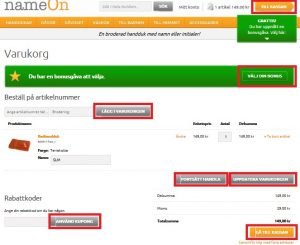
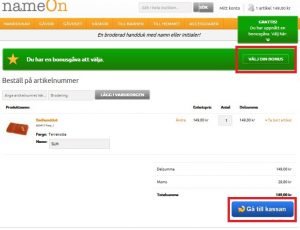
How analyzing visitor behavior using heatmaps could have helped nameOn make the most out of one experiment?
With the help of Heatmaps, nameOn could have studied the number of clicks that each CTA on the page receives. With actual user insights derived from the analysis of heatmaps and clickmaps data, nameOn could have done the following:
- Study which areas on the page get the most attention
- Discover which CTAs/hyperlinks on the page get the most/least clicks
For example, nameOn could have studied clicks on all CTAs and only removed the ones that were considerably cannibalizing the primary CTAs. It could also identify and place the primary CTAs in the most popular sections of the web page.
Use Case 2: Session Recording
Company: Drukwerkdeal, an online printing shop based out of the Netherlands.
Objective: To push more checkout actions from the product pages.
Hypothesis: Drukwerkdeal hypothesized that the cross-sell messages were doing more harm than good. Upon reviewing a number of its product pages, Drukwerkdeal realized that their cross-selling messages were not very convincing.
The Test: Drukwerkdeal decided to remove these messages from some of the page categories and test if this would have any impact on the sales. 14,000 visitors participated in this test that was run for two weeks. Read the full case study to know how the test went for Drukwerkdeal.
Images of control and variation are given below:
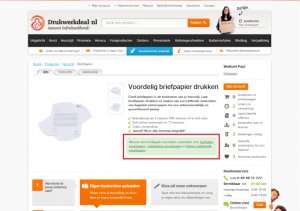
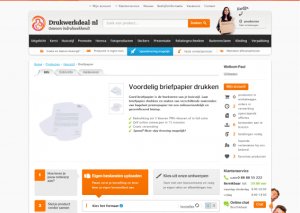
How analyzing visitor behavior session recording could have helped Drukwerkdeal make the most out of one experiment?
Although upsell and cross-sell help boost eCommerce conversions, at times these strategies might backfire. Using session recording, businesses can find out whether their upsell or cross-sell campaigns are getting them the desired results, or are proving to be a distraction. These recordings give accurate data about users’ entire journey on a website — where exactly they dropped-off, where they spent maximum time, from which point on a page they bounced off, etc. Based on this data, website owners can tailor an improved experience for users.
In Drukwerkdeal’s case, before removing the cross-sell messages from the product page, they could first analyze how people interact with the product pages. Using session recording, they could have played back the entire session of visitors who interacted with the product page. They could then validate whether users who clicked on a link in the cross-sell message returned to the original product page or not. It could then be established whether actually the cross-sell messages were proving to be a distraction on the product page.
Businesses like Drukwerkdeal from the eCommerce industry can identify not just one but multiple points of friction across a users’ journey in just one visitor behavior analysis exercise, and help you prioritize your ideas and decide which ones to test, of the ones that are to be tested, which ones to test first, and so on.
Travel
Travel companies majorly run their business online. Studying and understanding user and visitor behavior is, therefore, essential for them. The challenge for them is to convince visitors persistently on each step of the conversion funnel. Only a thorough understanding of visitor pain points and interest areas will help you improve customer experience.
Let us look at a use case on how visitor behavior analysis can help facilitate such understanding with data-backed insights:
Use Case: Session Recording
Company: Bizztravel Wintersport, a part of Bizz Travel Group.
Objective: To improve the navigation design such that searching and navigating the site becomes friction-free.
Hypothesis: There were a number of problems related to navigation that Bizztravel wanted to address.
For example, visitors browsing their site did not know that the village of Flaine is located in the region of Le Grand Massif. To find the Flaine page, a visitor had to click through an average of 5 regions. In such a navigation system, visitors were getting lost during a seemingly simple task of finding a vacation.
Bizztravel hypothesized that creating a clear and simple navigation menu would allow visitors to reach their desired vacation faster and reduce early exits caused by frustration or distraction. The idea was that the new header would make it easier for users to navigate, and therefore increase conversion rates.
Test: A variation was created with a new header that was redesigned for better navigation. It also had a drop-down menu, which allowed visitors looking for information such as the “Top 10 skiing destinations in France.” These changes reduced friction and clutter of information, as displayed in the control, and made it easier for users to navigate. Read the full case study to know how the test went for Bizztravel.


How session recording could have helped Bizztravel formulate hypotheses faster?
The primary goal was to track visits to Bizztravel’s “Thank You” page. Therefore, running session recording for those visitors who landed on the home page but did not arrive at the “Thank You” page could have helped Bizztravel identify the drop-off points on their homepage as well as in the conversion funnel. This would have helped them analyze and fix the points of friction in the journey of a visitor who wants to book a vacation. Studying visitor journeys by playing their recorded sessions could have helped Bizztravel arrive at a hypothesis faster.
B2B SaaS
For a B2B saas company, the forms on their website are the most important source of lead generation. Hence it is important that their forms be such that it does not have fields with ask for confidential information, does not have too many fields, does not lack context on why visitors should sign up, is placed in the most noticeable and popular section of the page, and so on.
Visitor behavior analysis helps you identify such leaks in your form design, placement, and flow and enables you to optimize it to it’s best version for the visitors. Let us look at a case study where a SaaS company increased form sign-ups using insights generated from conducting visitor behavior analysis.
Case Study 1: Website Form Analytics
Company: POSist, a leading SaaS-based restaurant management platform.
Objective: Increasing sign-ups on the contact us page.
From a business point of view, the ‘Contact Us’ page was one of the most important pages in POSist’s funnel. Hence, the team at POSist decided to run A/B test on the lead collection form on the page. They decided to conduct visitor behavior analysis to come up with data-backed hypotheses for the same. They used website form analytics to understand their audience’s form-filling behavior.
After analyzing the collected data, the team at POSist hypothesized that adding more context on what visitors will get by signing-up, adding prominent trust symbols, and reducing the width of the form will help them increase sign-ups.
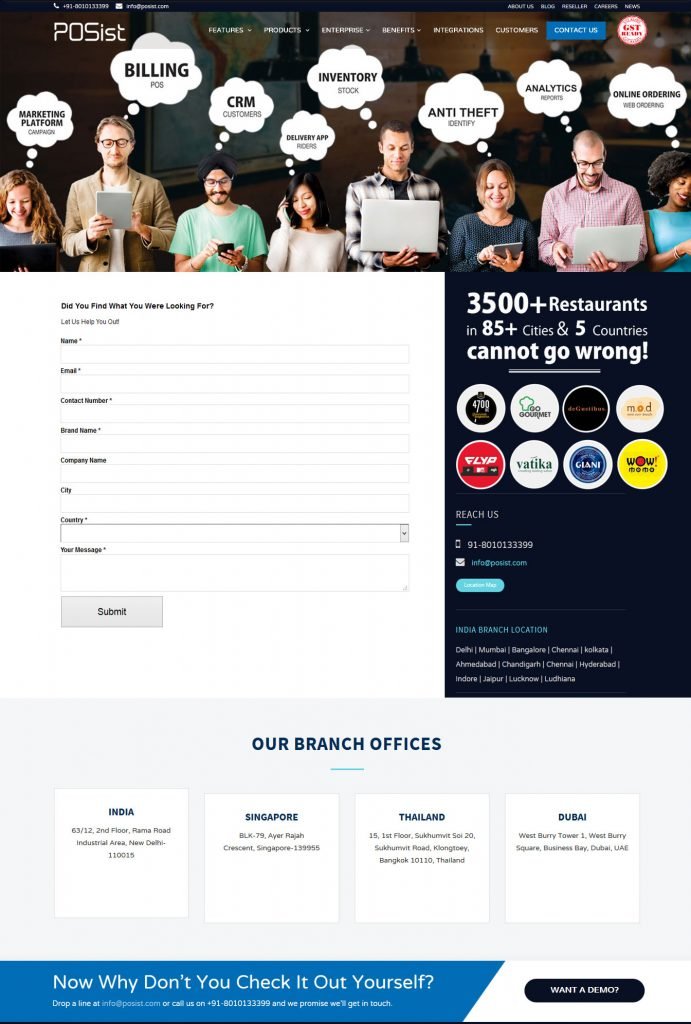
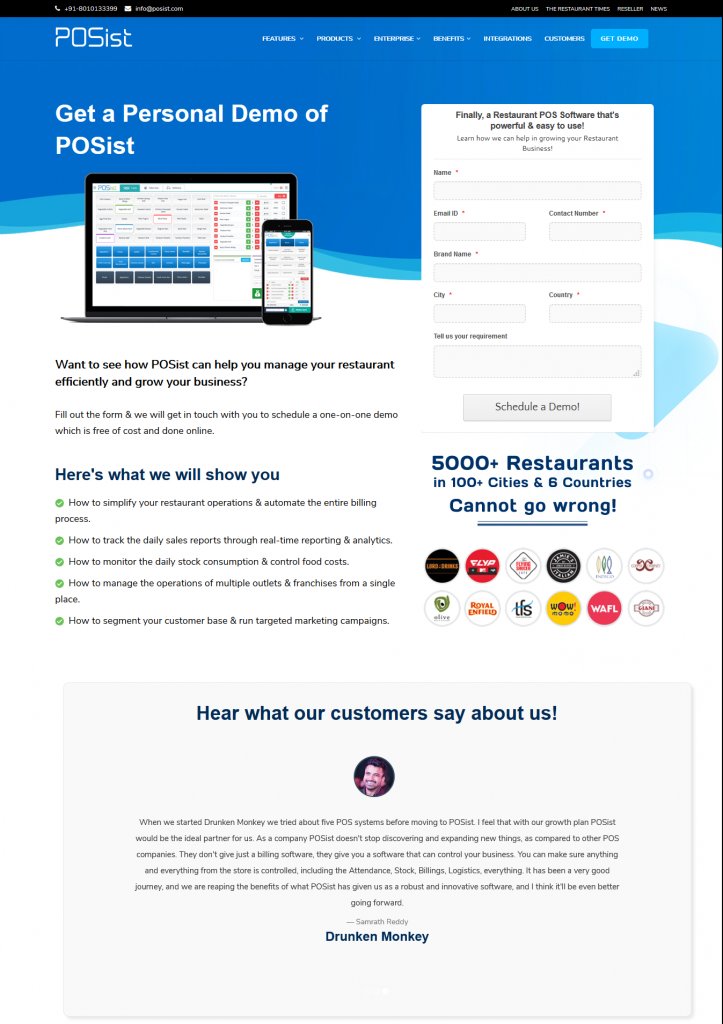
This test alone increased conversions for POSist by 20%. Based on the insights generated POSist ran a few more tests on the same element and increased their sign-up conversions even more.
Conclusion
This guide gives you an overview of what visitor behavior analysis is, the different tools that you can conduct visitor behavior analysis through, the benefits of conducting visitor behavior analysis, and the pitfalls to avoid. After reading it, you must now be equipped with all the information you need to decide on when you should start conducting visitor behavior analysis.
If you found this guide informative and useful, share it among fellow marketers and businesses so they can also up their experience optimization game by thoroughly understanding their visitors.
Frequently Asked Questions on Visitor Behavior Analysis
User Behavior Analysis is used for building stellar website experiences in order to increase conversions on your website.
Visitor Analysis research involves getting in the shoes of your visitors’ shoes to identify the popular sections amongst the visitors and thereby identifying friction across the visitor funnel.
In order to analyze a website efficiently, it is important to first understand the goals of the business and how they are tied to the website. After that, you can follow a set methodology that involves tasks, checklists, and processes to successfully analyze a website.
By reading the Behavior Flow report, you can visualize the path traveled by visitors from one page to the next. A thorough reading of the Google Analytics behavior flow report also allows you to discover what content is most engaging and plot customer journeys.
Businesses prefer using visitor analytics tools with a wide range of behavior metrics, as user behavior continues to get more unpredictable by the day. Qualitative methods like heatmaps, click maps, scroll maps, and session recordings make it super easy to deep-dive into visitor behavior on a website. If you’re planning to get started, you can try VWO Insights, one of the most loved user behavior analytics tools out there
Visitor tracking helps website owners understand every user’s journey on their website if they encounter any friction while trying to perform an action, or things that are aiding their experiences. Insights drawn from visitor behavior tracking enable you to optimize your website and enhance user experiences.
When quantitative data fails to show you why your users are behaving a certain way on your website, you must turn to qualitative data to study visitor behavior in depth. Heatmaps, scrollmaps, clickmaps, and session recordings are some of the most effective ways to get your hands on qualitative visitor data. With VWO Insights at your fingertips, you need not run one tool to another to try out all these methods. Be it setting goals, identifying leaks in your conversion funnel, or analyzing form conversion, this tool allows you to do granular analysis of visitor behavior on your website. Take a full-featured trial to explore more features of the VWO platform.
Although there are quite a few visitor analytics tools available, nothing beats the expanse of VWO Insights’ features. You can set funnels to discover where users drop off from your website, understand users’ interactions with your web forms, get visitors’ feedback through on-page surveys, and a lot more! And the best part is you can use insights from visitor behavior analysis to inform your website testing roadmap in the future.
A tool like VWO Insights will do most of the heavy lifting for you in this regard. It does a granular-level analysis of user behavior and offers detailed reports on it. What you must do is gather insights from those reports and put them into action. For example, if you see a lot of users abandoning your email sign-up form, you may want to test and optimize the form and see how it changes their behavior.










